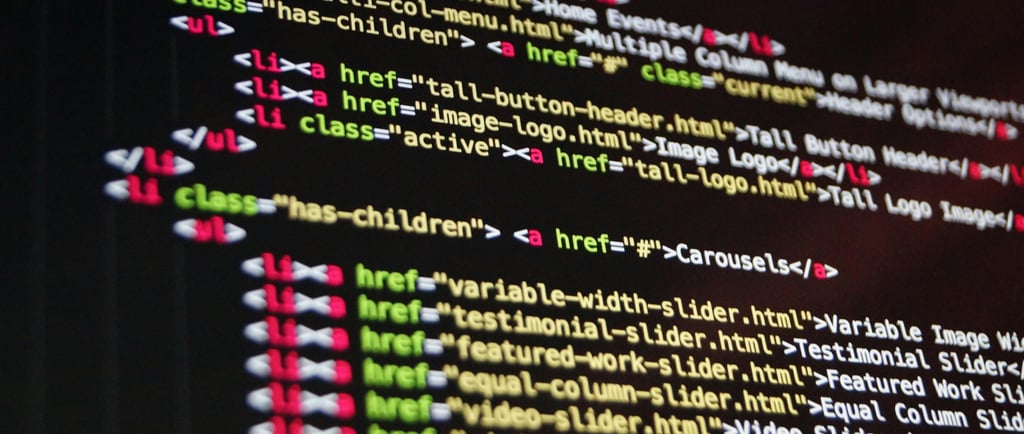A Beginner's Guide to Learning Web Development: Where to Start and What to Focus On
LEARNING WEB DESIGN & WEB DEVELOPMENT
5/26/20253 min read


Web development is one of the most in-demand and rewarding skills in today’s digital world. Whether you’re looking to start a new career, build your own website, or create an online business, learning web development can open up countless opportunities.
But if you’re a beginner, the journey can feel overwhelming. With so many tools, languages, and frameworks out there, it’s hard to know where to start or what to focus on first.
In this guide, we’ll break down the essentials of learning web development step by step, so you can approach it with confidence and clarity.
Step 1: Understand the Basics of Web Development
Before diving into coding, it’s important to understand what web development is and how websites work.
What Is Web Development?
Web development is the process of building and maintaining websites. It’s divided into two main areas:
Front-End Development: Focuses on the parts of a website that users interact with, such as the layout, design, and navigation.
Back-End Development: Handles the server-side logic, databases, and everything that powers the functionality behind the scenes.
Some developers specialize in one area, while others become full-stack developers, working on both front-end and back-end development.
How Websites Work
Websites are built using three core technologies:
HTML (HyperText Markup Language): Defines the structure and content of a webpage.
CSS (Cascading Style Sheets): Styles the webpage, including colors, fonts, and layouts.
JavaScript: Adds interactivity and dynamic behavior to the webpage.
Understanding these three pillars is the first step to becoming a web developer.
Step 2: Start with the Basics: HTML, CSS, and JavaScript
1. Learn HTML
HTML is the foundation of every website. It’s used to structure content into elements like headings, paragraphs, images, and links.
Here’s an example of basic HTML:
<!DOCTYPE html>
<html>
<head>
<title>My First Website</title>
</head>
<body>
<h1>Welcome to My Website</h1>
<p>This is a paragraph of text.</p>
<a href="https://example.com">Click here</a>
</body>
</html>
Start by learning how to create common elements like:
Headings (<h1> to <h6>)
Paragraphs (<p>)
Links (<a>)
Images (<img>)
Lists (<ul> and <ol>)
2. Learn CSS
CSS is used to style your HTML content and make it visually appealing. With CSS, you can control colors, fonts, layouts, and more.
Here’s an example of CSS in action:
body {
background-color: #f0f0f0;
font-family: Arial, sans-serif;
}
h1 {
color: #333; text-align: center;
}
Focus on learning:
Selectors (class, id, element)
Box model (margins, padding, borders)
Positioning (relative, absolute, fixed)
Responsive design with media queries
3. Learn JavaScript
JavaScript brings websites to life by adding interactivity. It allows you to create features like dropdown menus, sliders, and form validation.
Here’s a simple JavaScript example:
document.getElementById("myButton").addEventListener("click", function() {
alert("Button clicked!");
});
Start with the basics:
Variables and data types
Functions
DOM manipulation
Events
Step 3: Practice by Building Small Projects
The best way to learn web development is by practicing. Start with small, manageable projects to apply what you’ve learned. Here are a few ideas:
Personal Portfolio Website: Showcase your skills and projects.
To-Do List App: Practice JavaScript by creating an interactive list.
Landing Page: Design a simple webpage for a fictional product or service.
Blog Template: Create a basic blog layout with HTML and CSS.
Building projects will not only solidify your knowledge but also give you something to showcase in your portfolio.
Step 4: Learn Version Control with Git and GitHub
Version control is an essential skill for web developers. It allows you to track changes to your code and collaborate with others.
What Is Git?
Git is a version control system that helps you manage your codebase.
What Is GitHub?
GitHub is a platform where you can store your code online and collaborate with others.
Start by learning basic Git commands:
git init: Initialize a new repository
git add: Stage changes
git commit: Save changes
git push: Upload changes to GitHub
Step 5: Explore Front-End Frameworks
Once you’re comfortable with HTML, CSS, and JavaScript, you can start exploring front-end frameworks to speed up development.
Popular Front-End Frameworks
Bootstrap: A CSS framework for responsive design.
React: A JavaScript library for building user interfaces.
Vue.js: A beginner-friendly framework for building interactive web apps.
These tools can help you build more complex projects efficiently.
Step 6: Learn Back-End Development (Optional)
If you’re interested in full-stack development, you’ll need to learn back-end technologies.
Key Back-End Skills
Programming Languages: Learn a back-end language like Node.js, Python, Ruby, or PHP.
Databases: Understand how to work with databases like MySQL, PostgreSQL, or MongoDB.
APIs: Learn how to build and consume APIs to connect the front end with the back end.
Step 7: Join a Community and Keep Learning
Web development is constantly evolving, so it’s important to stay updated and connected with others in the field.
Join Online Communities
Reddit (r/webdev)
FreeCodeCamp forums
Twitter (follow web developers)
Stay Updated
Follow blogs, YouTube channels, and newsletters to learn about the latest trends and tools.
Final Thoughts
Learning web development may seem daunting at first, but by breaking it down into manageable steps, you can make steady progress. Start with the basics—HTML, CSS, and JavaScript—and practice by building small projects. As you gain confidence, explore frameworks, version control, and back-end development to expand your skill set.
Remember, web development is a journey, not a race. Stay consistent, keep practicing, and don’t be afraid to ask for help when you need it. With dedication and persistence, you’ll be well on your way to becoming a skilled web developer.